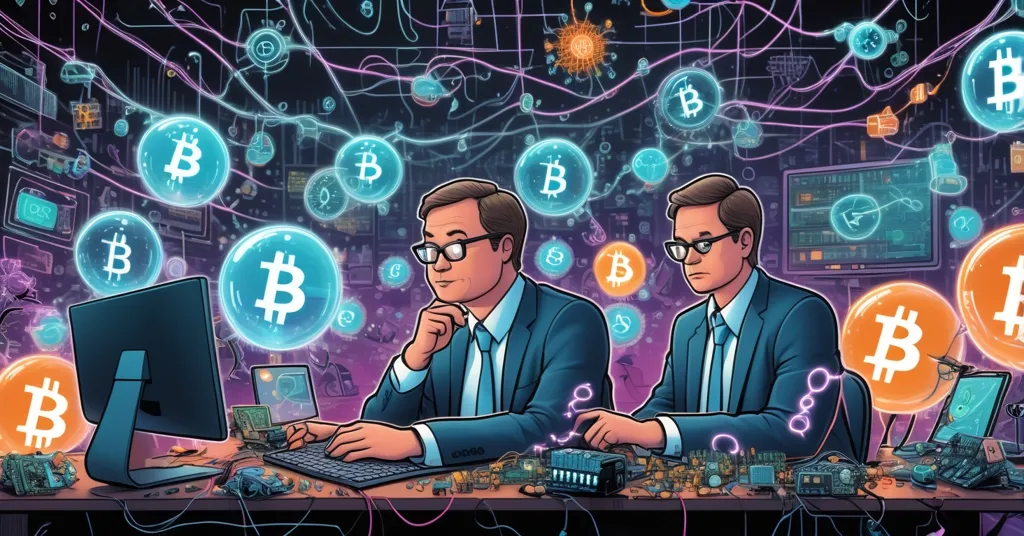Peter Thiel Dumps Nvidia, Slashes Tesla: Is the AI Hype Bubble Bursting?

Peter Thiel’s Shocking Nvidia Exit and Tesla Trim: Is the AI Party Over?
Billionaire venture capitalist Peter Thiel has dropped a bombshell on the tech investment world with a radical portfolio shake-up in Q3. Without a word of explanation, Thiel sold all 537,000 of his Nvidia shares—nearly 40% of his fund’s equity holdings—slashed his Tesla stake to just 65,000 shares, and cut his total long equity exposure by a staggering 65%. Revealed in a mandatory quarterly report known as a 13F filing, this move comes as Nvidia’s valuation skyrockets past $5 trillion and AI optimism dominates headlines. Is Thiel signaling the end of the AI hype train, and what can crypto investors learn from this seismic shift?
- Massive Nvidia Sell-Off: Thiel dumped 537,000 shares, exiting a key player in the AI boom.
- Tesla Stake Slashed: Reduced holdings to 65,000 shares, now 39% of his portfolio.
- Equity Exposure Cut: Portfolio value plummeted from $212 million to $74.4 million in one quarter.
Thiel’s Bold Pivot: What Happened?
Through his hedge fund, Thiel Macro LLC, Peter Thiel has executed one of the most dramatic portfolio overhauls in recent memory. Besides liquidating his entire Nvidia position, as detailed in recent reports, he also completely exited Vistra Energy, an energy company that previously made up 19% of his equity holdings. The result? A leaner, more focused fund now holding just three stocks: Tesla at 39%, Microsoft at 34%, and Apple at 27%. This isn’t a minor adjustment—it’s a full-scale retreat from risk, slashing his total equity value from $212 million in Q2 down to $74.4 million in Q3. For more on this stunning move, check out Peter Thiel’s massive Nvidia sell-off and Tesla reduction.
For those unfamiliar, a 13F filing is a required disclosure for large investors, offering a public glimpse into what heavyweights like Thiel are buying or selling each quarter. What makes this filing stand out is the sheer scale of the sell-off—and the deafening silence around it. Thiel, a tech titan who co-founded PayPal, was the first outside investor in Facebook, and chairs Palantir, has a track record that demands attention. When someone with his nose for disruptive innovation makes a move this aggressive, markets take notice, even if he’s keeping his lips sealed tighter than a Bitcoin private key.
Nvidia’s AI Boom Under Fire: Why Walk Away?
Nvidia has become synonymous with the AI revolution, powering everything from machine learning algorithms to self-driving car systems with its cutting-edge graphics processing units (GPUs). The company recently surpassed a $5 trillion valuation—yes, trillion with a ‘T’—driven by a 56% surge in data-center revenues year-over-year. Analysts are practically tripping over themselves with predictions of $1 trillion in yearly sales by 2030. So why on earth would Thiel dump every single share?
The answer might lie in his past skepticism. While he once dubbed Nvidia “the hardware leader in the AI race,” he’s also warned that the sector is caught in a “hype loop.” Investors, he’s argued, are banking on massive returns that could take 15 to 20 years to actually materialize—if they ever do.
Thiel has previously stated that “the AI market is in a hype loop,” with valuations reflecting profits that are “15 to 20 years” away.
His exit seems to scream that the current numbers, while impressive, might be more mirage than reality. Nvidia’s price-to-earnings (P/E) ratio, a common measure of whether a stock is overvalued, hovers at levels that make even bullish analysts sweat. For context, a high P/E suggests investors are paying a premium for future growth that may not come as fast as expected. Thiel’s move could be a bet that the AI bubble is inflating faster than a memecoin on a Twitter pump.
But let’s not ignore the other side. Nvidia isn’t just hype—it dominates the GPU market with innovations that underpin everything from gaming to generative AI like ChatGPT. Their data-center growth isn’t a fluke; it’s tied to real demand from tech giants building AI infrastructure. Still, if Thiel’s gut says the market is pricing in a utopia that’s decades off, his exit might be less about Nvidia’s tech and more about Wall Street’s frothy expectations. Trillion-dollar sales by 2030? That’s the kind of moonshot nonsense we’d mock in a shitcoin whitepaper.
Tesla Trim: Doubting Elon’s Vision?
Thiel’s history with Elon Musk goes back to their PayPal days, a bond that’s seen him back Musk’s ventures like SpaceX with early investments. Tesla, Musk’s electric vehicle and tech juggernaut, has long been a darling in Thiel’s portfolio. So, cutting his stake down to 65,000 shares—though still the largest holding at 39%—feels like a personal jab. Is this a lack of faith in Musk’s vision, or just a pragmatic step back from a stock often criticized for trading at prices far above its earnings?
Tesla’s valuation, much like Nvidia’s, often defies traditional metrics. Its stock price reflects not just car sales but grand promises of autonomous driving, energy solutions, and AI integration. Yet, delivery hiccups, regulatory scrutiny, and fierce competition in the EV space keep skeptics vocal. Thiel’s reduction might signal broader unease with tech companies riding high on future promises rather than current profits—a theme that’s starting to feel uncomfortably familiar.
A Growing Chorus of AI Skeptics
Thiel isn’t a lone wolf howling at the AI moon. Other heavyweights are flashing warning signs about the sector’s runaway optimism. Jeff Bezos, Amazon’s founder, didn’t mince words when he labeled AI an “industrial bubble.” Goldman Sachs CEO David Solomon has predicted a “12- to 24-month cooldown” for the market. James Anderson raised eyebrows over rumors of Nvidia funneling $100 billion into OpenAI, calling it “disconcerting.” And Michael Burry, the investor who foresaw the 2008 housing crash, is reportedly betting against both Nvidia and Palantir—Thiel’s own data analytics brainchild.
Jeff Bezos has called the AI craze an “industrial bubble,” while David Solomon warned of a “12- to 24-month cooldown.”
This collective skepticism paints a picture of a market teetering on the edge. Sure, AI’s potential to transform industries—from healthcare to logistics—is undeniable. But when valuations outpace realistic timelines for adoption and profit, even visionaries like Thiel seem to hit the brakes. It’s a cautionary tale that hits close to home for anyone who’s watched crypto markets swing wildly on unfulfilled promises.
Thiel’s New Portfolio: A Defensive Play?
Looking at what remains in Thiel Macro LLC’s holdings offers clues about his mindset. Tesla, Microsoft, and Apple aren’t exactly the wild gambles of an AI startup or a speculative energy play like Vistra. Microsoft and Apple, in particular, are as close to “safe” as tech gets—blue-chip giants with diversified revenue streams and decades of staying power. Tesla’s still a bit of a wildcard with its lofty valuation, but its cultural and market impact under Musk keeps it a heavyweight.
This trio suggests Thiel is battening down the hatches, favoring stability over the high-risk, high-reward bets that defined his earlier career. It’s a stark contrast to the moon-chasing ethos of Silicon Valley, and it raises questions about whether he’s bracing for a broader tech correction. With a past steeped in libertarian ideals and support for disruptive innovation—evident in his early praise for Bitcoin as a reserve asset—Thiel’s shift might hint at a deeper disillusionment with centralized tech’s current trajectory.
AI Hype and Crypto Parallels: Lessons for Decentralization
Let’s pivot to where this intersects with our core focus: Bitcoin, cryptocurrency, and blockchain technology. The AI boom and bust cycle Thiel seems to be betting against mirrors the speculative rollercoasters we’ve seen in crypto over the years. Think back to the 2017 ICO mania, where projects with nothing but a flashy whitepaper raised millions overnight, only to vanish when reality set in. Or consider the endless stream of DeFi protocols promising impossible yields—most of which collapsed under their own weight or outright scams.
In both AI and crypto, the pattern is clear: transformative potential gets drowned out by irrational exuberance. Nvidia’s GPUs might power the future, just as blockchain could redefine finance, but when valuations sprint ahead of adoption, crashes follow. Thiel’s move away from Nvidia echoes a sentiment many Bitcoin maximalists hold—stick to the fundamentals. Bitcoin, with its fixed supply of 21 million coins and decentralized network, often weathers speculative storms better than altcoins riding hype waves. It’s not sexy, but it’s resilient, much like Microsoft or Apple in Thiel’s trimmed-down portfolio.
Moreover, Thiel’s apparent distrust of centralized tech giants’ overblown promises aligns with the ethos of decentralization we champion. AI’s current trajectory is largely driven by massive corporations—Nvidia, OpenAI, Google—whose control over data and infrastructure raises privacy and power concerns. Compare that to Bitcoin’s peer-to-peer network, where no single entity calls the shots. If Thiel’s pivot is partly a rejection of centralized tech’s unchecked growth, it’s a subtle nod to the freedom and autonomy blockchain offers. Could his next move be a heavier bet on crypto’s decentralized future? That’s pure speculation, but it’s worth pondering.
Another angle to chew on is regulation. Tech giants like Nvidia and Tesla face increasing scrutiny over everything from antitrust to data practices, much like crypto battles with agencies like the SEC over unclear rules and crackdowns. If Thiel’s sell-off partly reflects fears of a regulatory hammer dropping on tech, it’s a reminder of why decentralized systems—free from single points of failure—matter more than ever. Bitcoin doesn’t care about a CEO’s misstep or a government’s mood swing. That’s a strength no AI stock can match.
Market Implications: A Canary in the Coal Mine?
Thiel’s radical shift isn’t just personal portfolio management—it’s a signal that could ripple through markets. With a track record of spotting trends and bubbles, his 65% equity cut might spook other investors, especially in a tech sector already jittery about overvaluation. If more funds follow suit, we could see a cooldown in AI and growth stocks, pushing capital toward safer assets. For crypto enthusiasts, this raises an intriguing possibility: could Bitcoin, often seen as digital gold, become a refuge for capital fleeing volatile tech?
Looking ahead to 2025, Thiel’s caution might prove prophetic if AI adoption lags behind investor expectations or if economic headwinds—like rising interest rates—curb tech spending. On the flip side, if Nvidia and its peers deliver on their lofty promises sooner than expected, Thiel could miss out on massive gains. For now, his actions align with a growing unease among contrarians. Michael Burry’s bets against Nvidia and Palantir, for instance, suggest the “Big Short” veteran smells blood in the water. Whether this is the start of a broader sell-off or just a blip remains anyone’s guess.
Key Questions and Takeaways for Crypto and Tech Investors
- Why Did Peter Thiel Sell All His Nvidia Shares?
Thiel hasn’t spoken on this move, but his earlier warnings about AI being overhyped, with returns possibly decades away, suggest he sees current valuations as disconnected from reality. - Is the AI Boom at Risk of Collapsing Like a Crypto Bubble?
With Thiel’s exit and skepticism from figures like Jeff Bezos and David Solomon, there’s a clear concern that AI’s growth is overblown, mirroring speculative crashes in altcoins and DeFi. - What Does Thiel’s Tesla Cut Signal for Tech Markets?
Reducing his stake hints at doubts about even iconic tech names like Tesla, reflecting broader unease with stocks trading far above their earnings—a cautionary note for speculative investments. - How Do Thiel’s Moves Connect to Bitcoin and Crypto?
His retreat from high-risk tech parallels crypto’s own hype cycles, underscoring Bitcoin’s stability as a decentralized asset compared to volatile altcoins or overvalued tech stocks. - Are Other Big Investors Questioning AI and Tech Growth?
Yes, from Bezos calling AI an “industrial bubble” to Burry betting against Nvidia, a wave of doubt is building, potentially impacting sentiment across tech and crypto markets.
Peter Thiel’s silent but seismic portfolio gutting leaves us with a glaring lesson: hype is a hell of a drug, whether it’s AI chips or altcoin promises. His move might be a personal reallocation, or it could be the first crack in the tech bubble’s foundation—a warning for anyone betting big on moonshots. For those of us in the crypto space, it’s a reminder to stay grounded. Stack sats, think critically, and don’t drink the Kool-Aid. The market’s next act, whether in Silicon Valley or on the blockchain, is anyone’s guess—but ignoring a titan like Thiel isn’t an option.



